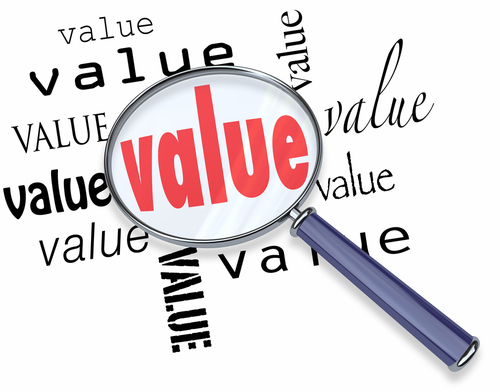One mystery is why clients fail to see the value of library services. Objectively, libraries might deliver high-quality information that precisely meets user needs. Subjectively, the services are often under-valued. Sometimes they are under-used. We discovered some concepts which helped us understand this.

Used under licence from Shutterstock.com
As producers we see our services/products in terms of absolute value, whereas clients see them in terms of relative value. So, if perfect information on a topic is 100% and we can offer something that rates 75% then that looks quite compelling. Except the client has probably already checked ‘Googlypedia’ and got information worth 60%. The value of our offer to them is worth not 75% but 15%. To get that extra 15% they have go through all the steps needed to obtain library service and filter the response to match their needs. The relative value is much less compelling than the absolute and this can lead to both under-valuation and under-use. It can be a rational consumer response based on experience and reputation.
The problem of relative value is exacerbated by the competition being seen as ‘free’ whereas using the library is seen has having a cost. As has been frequently demonstrated, ‘free’ is not just another point on a scale. It has a psychological impact that goes beyond the rational calculation of costs and value. ‘Googlypedia’ is not really free, of course, and neither are sources like lobbyists. But the Assistant can use them quickly and easily without special effort or leaving their desks. By contrast, the library is more difficult and may require time to explain the problem and to negotiate its systems. Especially if the client has no past experience or trusted personal contact in the library, the cost of the system and the value of the outcome are uncertain. And even known high quality can be an inadequate defence against ‘free’.
The concept of the ‘value curve’ also delivered some insights. Comparing our services to the competition we found that we were probably outperformed by at least one competitor on the most important aspects of service for Members. (The Assistant could deliver more customisation, the lobbyist and research function more specialist personal knowledge…and so on). The aspects on which we might lead – range and quality of information, objectivity – are important to at least some Members some of the time, but not all Members all of the time. In fact, the sad conclusion we reached was that information service per se was not a compelling offer for Members, no matter how high-quality it was – we had to find a different value proposition.
The ‘value curve’ also made us consider if libraries (and not only parliamentary ones) are busy comparing and converging on elements of professional ‘best practice’ – without questioning enough whether these investments matched clients’ sense of value. Libraries are too good for their own good. They try too hard to be perfect and quite possibly over-deliver in relation to client real needs. (For example, the quality of cataloguing and indexing). This means that costs will be out of proportion to the perceived value. Worse, because libraries try so hard to match multiple supposed needs their offer tends to be complicated, with many choices. Too much choice, perhaps – as behavioural economics suggests that potential customers confronted with too many choices are more likely to walk away.
But if these insights helped us understand our value problems, how do we solve them? We have no magic solution but a future post will describe some ideas we have to address these issues.
Some sources:
Ariely, D. (2009). Predictably irrational. London: HarperCollins
Chakrabortty, A. (2008). Why we buy what we buy. The Guardian, 20 May 2008. Retrieved 10 June 2012 from http://www.guardian.co.uk/money/2008/may/20/consumeraffairs.economics
Kim, W.C. & Mauborgne, R. (1999). Creating new market space. Harvard Business Review 77(1), 83-93
Kim, W.C. & Mauborgne, R. (2005). Blue ocean strategy. Boston, USA: Harvard Business Review Press








[…] second came from Iain Watt. He published the third of his series of posts presenting the value of libraries. This time he asked – are we better than our competition? Ever heard of […]